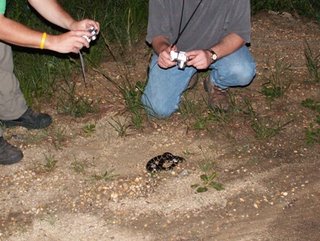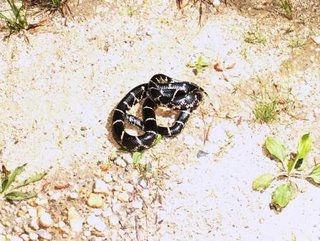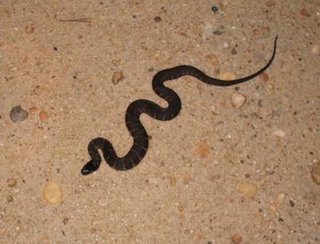At the end of June it was the eastern kingsnakes (Lampropeltis g. getula); this past Sunday (July 9th) it was a northern pine snake (Pituophis m. melanoleucus). What’s next, a coastal plains milk snake (Lampropeltis triangulum temporalis)? I need to be careful with that kind of joking or the Pine Barrens gods will curse me with bad luck again.
The northern pine snake is one of the iconic herp species of the Pine Barrens. It’s a pine snake, after all. These are big, powerful constrictors that burrow into sandy soil and chase gophers down in their tunnels. They can be beautiful snakes, with a cream background with black and deep brown spots.
Part of the challenge of finding pine snakes is that they spend most of their time underground. Even though you might be in the middle of a big population of them, you won’t necessarily know it since you can’t see them. They are also kind of rare; New Jersey classifies them as threatened. These big snakes need a lot of land, and since they’re big and don’t move too fast, they don’t do well crossing roads.
In hot weather they generally move on the surface early in the morning. So, early in the morning, so early it hurts me to think about it, Scott picked me up. After the obligatory Wawa stop, we raced the rising sun into Ocean County, New Jersey. There is a lot of Pine Barrens out there, but we were headed for a couple locations where Scott had found them before. Keep in mind that Scott has not found them with much frequency: he had caught 3 live pine snakes before Sunday, and he had seen only a few more dead ones on the road.
Our plan was to drive the sand roads of the pine woods and keep an eye out for pine snakes crossing in front of us. I’ll say quickly that this did not work for us. We found lots of dead snakes that way – garter snakes (Thamnophis s. sirtalis), eastern milk snakes (Lampropeltis t. triangulum), rough green snakes (Opheodrys aestivus) – and even some dead turtles – one box turtle (Terrepene c. carolina) and one common musk turtle (Sternotherus oderatus).
We found the pine snake after this strange looking guy (kind of a short, tattooed Jesus) with his large wife and little kid flagged us down to give them a jump. That’s an odd experience – coming across a stranded family early in the morning in the middle of the Barrens.
Anyhow, after the good deed of the morning, we drove on to where this promising sand road branched off and we parked. It turned out to be a short cul de sac, and towards the end of it I heard something rustle in the underbrush.

I heard it again, not far enough from the first rustle to be a fence lizard – this was something slower. I finally fixed on the motion and found a toad: a small Fowlers toad (Bufo fowleri), one of the millions and millions of Fowlers toads that rule the Pine Barrens.
They might look fat and clumsy, but toads have a habit of hopping right when you’re sure you’re about to grab them. I missed him a few times, and I was ready to try another grab when Scott called out from maybe thirty yards away. He had found some boards that looked promising. I looked at the toad, I thought about it a moment, and then I decided I could give up on that one.


I walked over and realized how cool this board pile was. I’m still not sure what it was originally, but what we found was several square yards of wood planks neatly lined up and mostly buried in sand, with some small plants growing in between here and there. The boards were set on cross beams, leaving some space between them and the sand below. I almost think it was the floor to an old structure, or maybe an old wall that had tipped over and was being swallowed up by the Barrens.
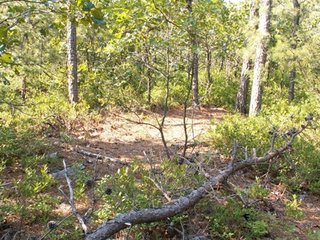
Scott worked with his Stumpripper and I with my hands (I can’t find my cultivator). We picked up a board and put it back down. We picked up the next to look and repeated. Suddenly I spotted something moving right in front of my face.
It was a pine snake! I shouted and grabbed it right away. I had kind of been hoping for a good defensive display – pine snakes are famous for rearing up off the ground and hissing really loudly – but this one was pretty placid. She hissed a little, but did not thrash around and did not bite. She also didn't hold still very well for photos, so here are a bunch of photos with us holding her.




Maybe she was worn out. A lot of the pine snakes we’ve heard of people catching in June were gravid females, and this big girl (at least four feet long) looked a little skinny. The timing’s right for her to have recently laid eggs.
Scott found a couple mouse nests in that board pile, and I found what we think was the pine snake’s shed skin.

We figure that board pile might be her home base, or at least she’s been hunting around it lately to eat and gain some of her weight back.
We didn’t find much else that day, but we didn’t need to. I went back and got my toad, and then a few more later on. We spotted some fence lizards, but that was it. One snake, a few toads and fence lizards, and zero turtles, salamanders, and frogs might not be a spectacular total, but when you spend months looking for something and finally find it, your high defies all usual complaints. Even the ticks didn't bother us too much, and there were a lot of ticks.

And of course there were the blueberries. It’s that time of the year again, when hungry Pine Barrens herpers can forgot about bringing snacks on the trip, because the snacks are growing wild all around them!
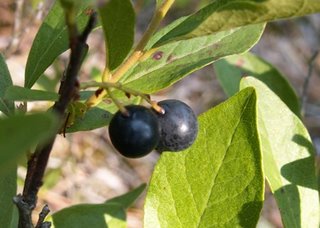
The temperatures started in the mid 60s, but were in the high 70s when we found the pine snake. It was sunny.
Totals:
1 DOR eastern milk snake
2 DOR eastern garter snakes
1 DOR common musk turtle
1 DOR eastern box turtle
1 DOR rough green snake
1 DOR black rat snake (Elaphe o. obsoleta)
2 fence lizards
7 Fowler’s toads
About 7 calling green frogs (Rana clamitans melanota)
1 northern pine snake



